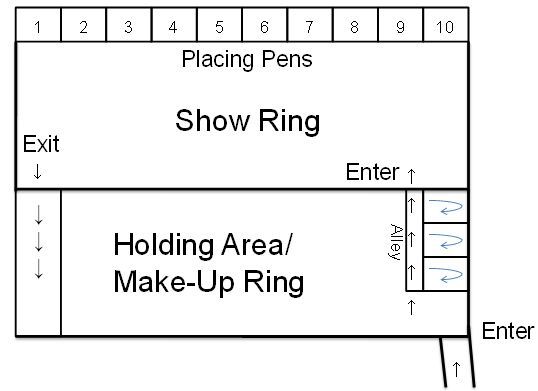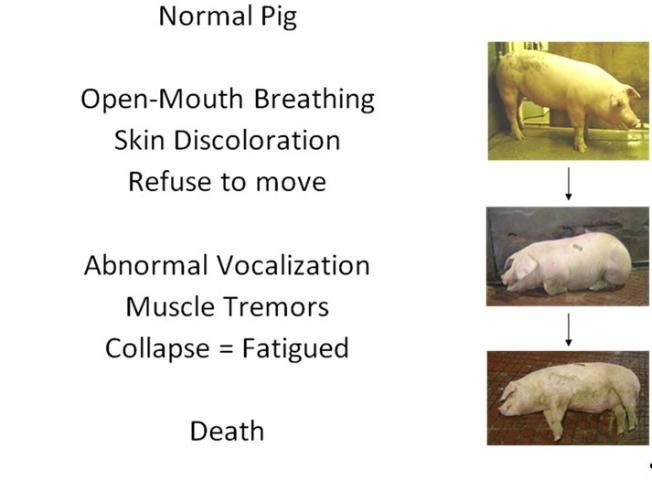The goal of this publication is to provide information about the proper handling of pigs during a swine show for youth to help show managers ensure a successful and educational show for all who participate. The management team for a swine show for youth should have a plan to manage the facilities, pigs, and personnel in a way that allows the show to be as stress-free and educational as possible.
Not every state or county has a world-class facility for agricultural exhibits. However, it is important that the show management team maximizes the available facility resources to have the best event possible. Show management should prepare the facility for every moment from pig arrival to departure to make sure the show is the best it can be. This publication includes a checklist of information about unloading pigs, the size of the show ring, and pig handling training so that show managers know how to prepare for their show.
Unloading
The stress of transportation, unloading, and co-mingling pigs can result in animal welfare problems for exhibited market hogs. Here is a list of things to consider when unloading pigs:
- Try to have unloading occur out of the public's eye.
- Have a safe, adjustable chute with solid walls and floors and secure footing.
- Minimize unloading time, because a long wait can result in heat-stressed pigs.
- Have an area available for fatigued pigs to rest after unloading.
- Provide access to water for all pigs.
Additional information about penning pigs within the barn and general show day suggestions applicable to all meat animal species can be found in Carr et al. (2011) Conducting a Successful Livestock Show for Youth, available at https://edis.ifas.ufl.edu/an268.
Show Ring Needs Specific for Swine
Each market weight hog should have 45–50 ft2 to be exhibited within the show ring. If much less space is allowed, pigs will remain too crowded. If much more space is allowed, it is more challenging for the judge and spectators to watch the show.
The following can be used as suggestions for show ring dimensions, depending on the average number of pigs per class:
- 5–7 pigs: 30' X 15' ring
- 10–12 pigs: 36' X 15' ring
- 15–17 pigs: 36' X 21' ring
- 20+ pigs: 36' X 27' ring
Show management should consider the following suggestions for setting up the show ring:
- Shows should have a holding area/make-up ring where pigs in the next class are "on deck" to improve the speed, organization, and efficiency of the show.
- Exhibitors should enter the show ring with their pig, one at a time. This is probably the best and most important look the judge will get of each exhibitor's pig.
- The show ring should have separate entrance and exit gates. This will minimize congestion of pigs and exhibitors.
- Shows with classes of more than 7 pigs per class must have enough placing pens to place half of the pigs exhibited in each class. This minimizes chaos and allows the crowd and exhibitors to follow the show and learn from the judge's comments.
Figure 1 shows an ideal set-up for a large hog show with more than 10 pigs per class. The same general set-up should be used with smaller shows, though not as many placing pens will be required.

Credit: Chad Carr, UF/IFAS
Pig Handling Training
A single incident of poor animal handling within a public forum is unacceptable. If pigs are not handled properly, it could have a very negative impact on that show and the people involved in the junior livestock business. More importantly, it could also harm the public perception of people in commercial pork production who are helping to feed the world.
Pigs are very susceptible to stress, which makes pig handling important during the show. Poor pig handling (such as a board handler or exhibitor being positioned in the wrong place or pushing a pig too hard) can contribute to pigs becoming fatigued. Fatigued pig syndrome is defined as a pig "without obvious injury, trauma, or disease that refuses to walk or keep up with its contemporaries" (Figure 2; Ritter et al. 2005). This is what happens when a pig "gets too hot" or becomes "stressed out," and then "goes down."

Credit: Photos courtesy of Dr. Matt Ritter, http://www.meatami.com/Education/Presentations/2007/AnimalHandling/RitterHandlingChallengesNonAmbulatoryPigs.pdf
Pigs became fatigued by the interaction of multiple factors including pig handling, genetics, use of growth-promoting feed ingredients, ambient temperature, and relative humidity. Pig fatigue results from the pig's muscles making more lactic acid than the heart and lungs can efficiently clear from the body. More muscle mass can make more lactic acid. Youth market hogs generally are very heavily muscled and can be very susceptible to fatigued pig syndrome.
It is important that all exhibitors and ring worker/board handlers receive some training on pig handling prior to the start of the show. This will not only improve the flow and speed of the show but also improve animal welfare and hopefully reduce incidents of fatigued pigs. The training should include information on the following:
- Where workers should place themselves to move pigs in a desired direction
- How to minimize stress when handling pigs during the show
- What to do if a pig becomes fatigued during the show
Figure 3 shows the interaction between pig behavior and handler location. The large circle around the pig is the flight zone, or how close you can get to an animal without it taking flight. Most all exhibited pigs will have no flight zone and will need to be touched on the back to move. The point of balance is at a pig's shoulder. If the pig handler stands behind the point of balance, the pig will move forward. The pig will back up or turn around if the handler comes in from the point of balance.

Credit: National Pork Board's TQA Handbook, 2004.
When possible, all handlers should move pigs in small groups (3–5 pigs) at a steady handling speed, with little to no handler vocalization and limited use of boards or show sticks.
If a pig starts to become fatigued, slow down immediately, allow the pig to rest, and possibly spray it with water. Slowly move the pig to a pen attached or adjacent to the show ring and away from pig and people congestion. Most pigs will recover within 2–3 hours (Ritter et al. 2005).
Conclusions
The management team for a swine show for youth must work with the facilities, pigs, exhibitors, and volunteers to make sure that the show is as stress-free as possible. This means having a plan to make sure pigs are unloaded and handled properly, designing the show ring so that it has space for the right number of pigs, and teaching volunteers how to recognize when a pig is fatigued or stressed. If a show runs smoothly and as planned, it will maximize the educational value of the swine show for youth.
Literature Cited
Ritter, M., M. Ellis, M. Benjamin, E. Berg, P. DuBois, J. Marchant-Forde, A. Green, P. Matzat, P. Mormede, T. Moyer, K. Pfalzgraf, M. Siemens, J. Sterle, T. Whiting, B. Wolter, and A. Johnson. 2005. "The Fatigued Pig Syndrome." Journal of Animal Science 83 (Suppl. 1):258.
Stahl, C. (ed.). 2004. Trucker Quality Assurance® Handbook. Des Moines, IA: National Pork Board.